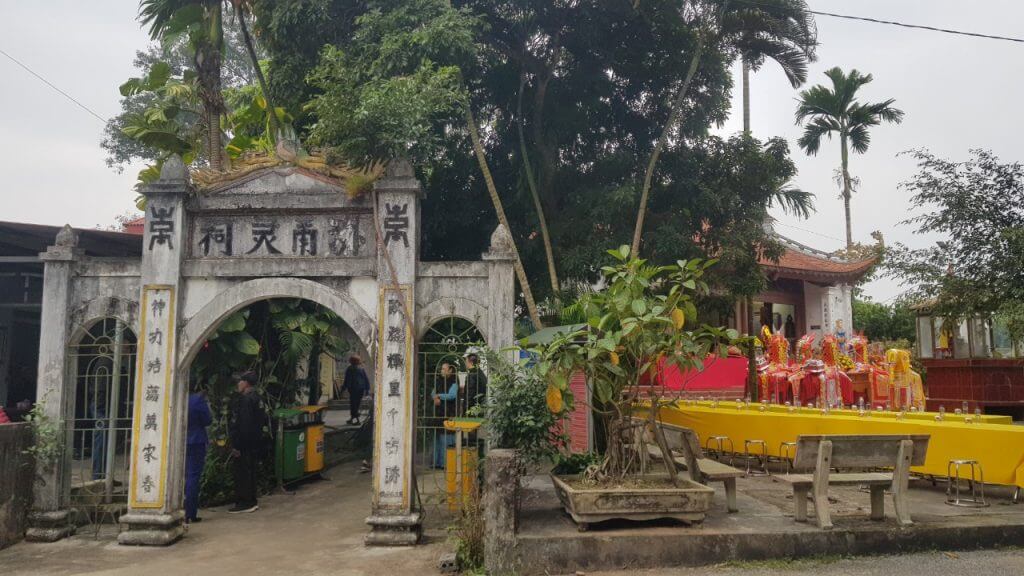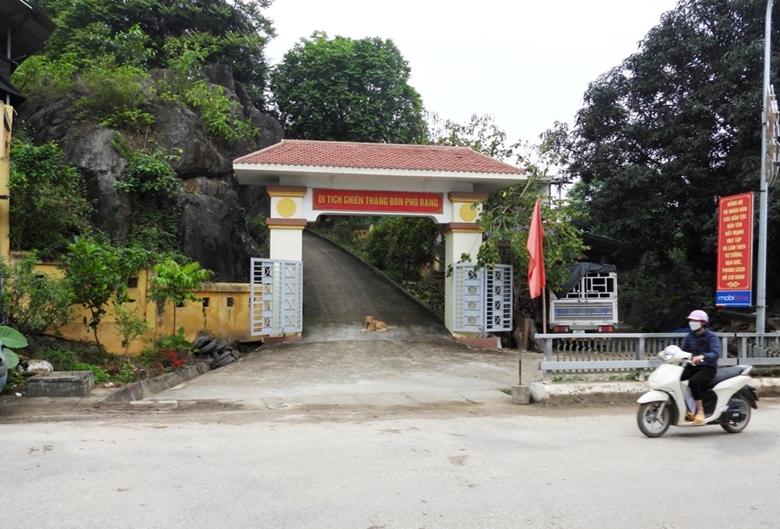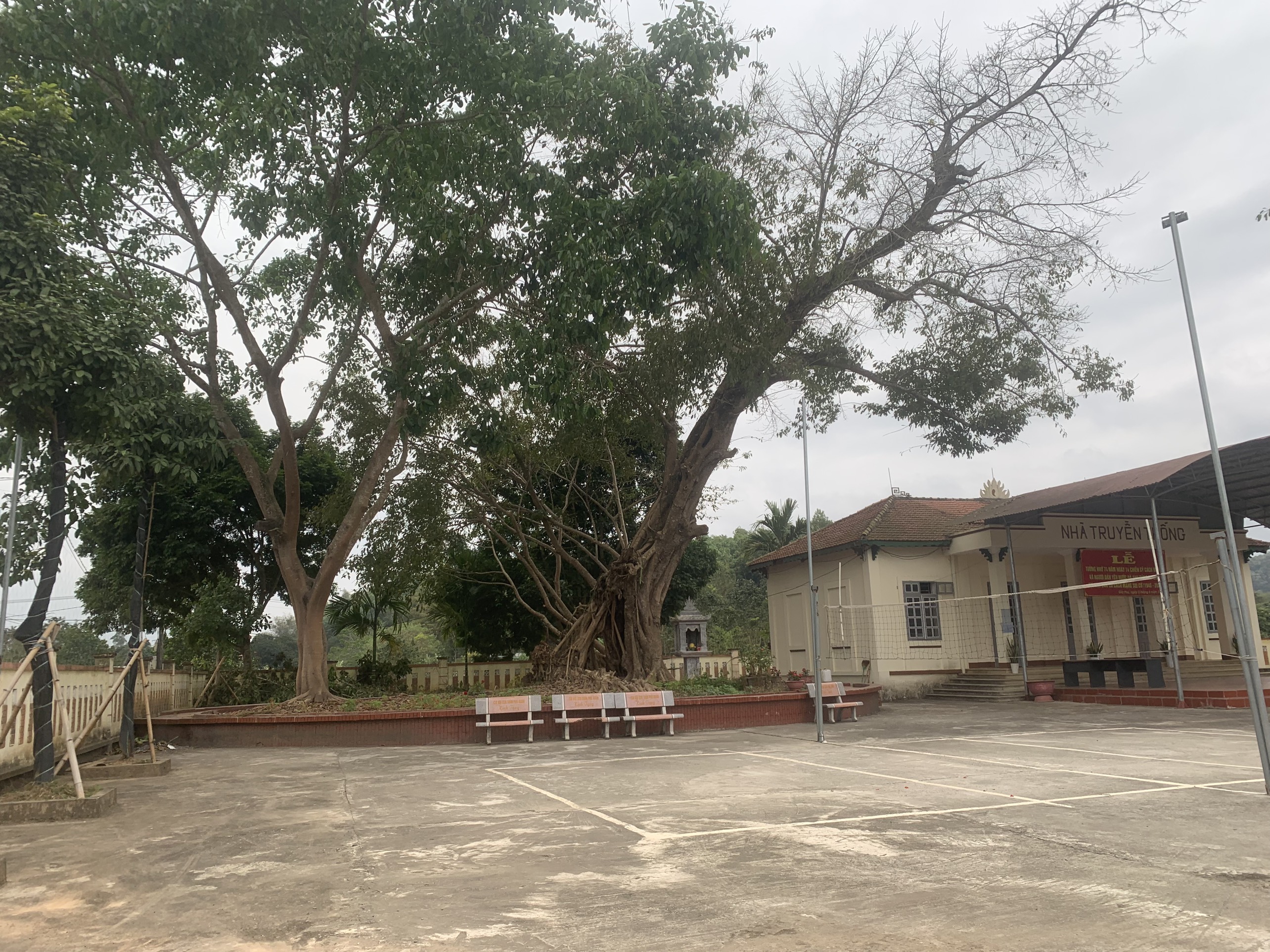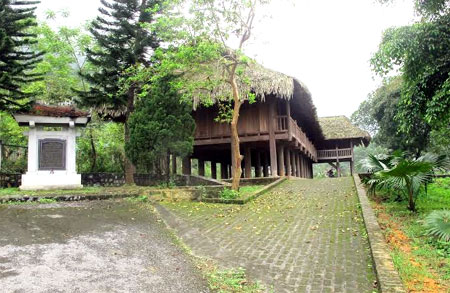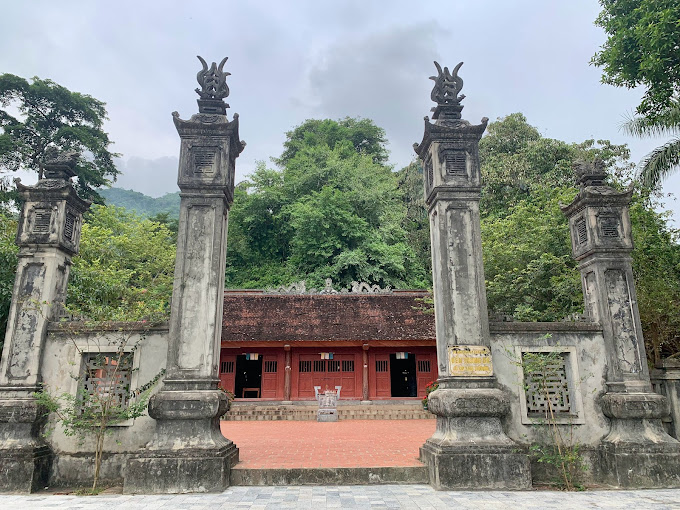Relic point Vietnam
Việt NamNgoi Bo Temple
Ngoi Bo Temple now belongs to Thong Nhat commune, Lao Cai city, Lao Cai province. Overlooking the river confluence - the intersection of Ngoi Bo stream and the Red River, the temple is a place to worship Tan Vien Son Thanh - one of the Four Immortals of Vietnamese folk beliefs, "the most sacred deity of Vietnam". Southern Heaven". According to the elders, when the people from the lowlands in the village came here and were attached to this land, they built shrines and temples to worship Saint Tan Vien - a Saint who is worshiped throughout the midland and Northern Delta with devout belief in His blessing and protection. That trust is the pedestal and spiritual fulcrum of those far away from home on the path to creating a life in a new land, and at the same time is a reminder and maintenance of memories of their homeland. about his ancestors' origins. Ngoi Bo Temple Festival takes place on January 11 every year. Ngoi Bo Temple was ranked as a Provincial historical-cultural relic in 2016 Source Lao Cai province electronic information portal.
Lao Cai 2103 view
Pho Rang Fort Historical Relic
Pho Rang Fort National Historical Site in Pho Rang town, Bao Yen district (Lao Cai) is a special testament, where the heroic and glorious historical victory of our ancestors' generation 73 years ago is engraved ( June 26, 1949 – June 26, 2022). According to the History of Bao Yen District Party Committee (Lao Cai), Pho Rang station was built on peak 442, with an area of nearly 1 hectare; This is a strategic location, able to control the entire basin area of Pho Rang town and surrounding areas. The station has almost three sides of the river, so the station can cover and monitor all activities on the river and both sides of the river. The French built a solid fortification system with many bunkers, trenches, dense sharpened bamboo fences around the base, mines, obstacles and gun emplacements were arranged around the station. The enemy also arranged 2 platoons of European and African soldiers, 1 team of red soldiers, 1 platoon of paratroopers, 1 platoon of soldiers, all kinds of weapons ready to fight back and block the progress of our military branches to liberate the region. Northwest. On June 11, 1999, Pho Rang Fort relic was recognized by the Ministry of Culture and Information (now the Ministry of Culture, Sports and Tourism) as a National Historical Relic, according to Decision No. 38/QD-BVHTT . Source: Ministry of Culture, Sports and Tourism.
Lao Cai 2347 view
Historical relic of Pho Lu Fort Victory
Historical Relics The Victory Site of Fort Pho Lu is surrounded by high mountains, dense forests, steep cliffs, and deep rivers and streams. There are 2 clusters of blockhouses: the near cluster and the far cluster. The nearby cluster has 3 blockhouses: Number 1 was swept away by a flood in 1971 due to landslides. Number 2 is made of 4.5m long, 4.5m long and 3.7m wide concrete. Number 3 is 900m from Pho Lu station. The remote cluster has 2 bunkers built on top of a hill about 50 - 70m high. The center of the station is the Command Post, now house number 244 Le Hong Phong Street. There are also barracks and many solid concrete underground bunkers, currently only 5 remain. Source Lao Cai province electronic information portal.
Lao Cai 2596 view
Soi Co and Soi Gia relic sites
Bao Thang is a district with a long history of revolutionary tradition, a rich system of historical relics and a rich national cultural identity. On July 24, 2007, Soi Co - Soi Gia revolutionary base area in Gia Phu commune was ranked by Lao Cai Provincial People's Committee as a provincial relic. This is a relic that has existed for nearly a century, one of the important revolutionary bases located in the large operating area of Cam Duong - Gia Phu - Xuan Giao. Especially in the period 1947 - 1950, Soi Co - Soi Gia built a quite solid revolutionary base, received enthusiastic response from the people, so the national revolutionary movement was strongly promoted, tour groups The raid caused many losses to the enemy army. Therefore, they organized brutal repression and killed many of our revolutionary bases in order to intimidate the struggle movement here... Soi Co - Soi Gia revolutionary base area marked the revolutionary struggle. "It is one of the important and valuable relics of Bao Thang district." Source Lao Cai province electronic information portal.
Lao Cai 2401 view
Pu Gia Lan historical relic site
Arriving at Van Ban, entering the town center, you will see the majestic Gia Lan mountain appearing before your eyes. At the foot of the mountain is a long valley, a dense and crowded land. Gia Lan Mountain not only has majestic and poetic beauty but is also famous because it was the secret base of Van Ban's army and people during the resistance war against the French. Today, this base has become a revolutionary historical relic area that people know as the Pu Gia Lan Guerrilla Area. Pu Gia Lan guerrilla area was formed in 1947 in the Gia Lan mountain area, Khanh Yen Thuong commune. This is a secret base in the enemy area directed by the Van Ban District Party Committee to build, contributing significantly to the liberation of Van Ban district in particular and Lao Cai province in general. When the French colonialists occupied Van Ban, the people of Lang Giang, Khanh Yen Thuong, Khanh Yen Ha communes evacuated to this mountainous area. Along the mountainside from Lang Giang to Khanh Yen Ha commune, there are displaced people everywhere. Gia Lan guerrilla zone includes the entire land of Lang Giang commune, the southern part of the communes: Khanh Yen Thuong, Khanh Yen Ha, Chieng Ken. The North borders Nam Rang commune, the South borders Nam Tha commune, the Northwest borders Duong Quy commune, the Southwest borders Nam Xe - Van Ban commune and part of Than Uyen (Lai Chau). Gia Lan guerrilla area is a place to meet officials, soldiers, and guerrillas to discuss plans to carry out short training sessions, a place to facilitate communication from Lao Cai (in the past) to other countries. outside the province. Pu Gia Lan relic site is an important revolutionary relic site that contributes to educating revolutionary consciousness for future generations, while preserving the relic site is protecting the ecological environment. On November 16, 2006, the relic was recognized by the Provincial People's Committee as a provincial relic. Gia Lan Mountain with its natural wall has witnessed the maturity of the revolution in the countryside imbued with folk culture, witnessed the achievements of the Party leading the people of all ethnic groups to fight the French, liberating the homeland of Van Ban. ./. Source: Lao Cai province electronic newspaper.
Lao Cai 2022 view
Ken Temple cultural and historical relic
Ken Temple located in Chieng Ken commune, Van Ban district has long been an address attracting many people to visit and worship. In 2006, Ken Temple was ranked as a provincial cultural and historical relic by the Lao Cai Provincial People's Committee. Since then, Van Ban district has been implementing plans to restore and upgrade the temple to attract tourists from all over to visit and worship. Trinh Tuong Mau Temple Festival - Spiritual tourism destination Ken Temple is located on top of Pu Dinh hill, in the heart of Ken village with a land area of over 10,000 m2. The temple worships Mr. Nguyen Hoang Long and the generals of the Tay Son insurgent army who had the merit of repelling invaders in Van Ban's homeland, helping people of all ethnic groups here clear their fields and protect their villages. Every year, on January 7, people hold an incense offering ceremony to commemorate his contributions. In 2006, Ken Temple was officially renovated, rebuilt spaciously and ranked as a provincial-level historical and cultural relic by the Lao Cai Provincial People's Committee. At the end of 2012, the Provincial People's Committee approved the Ken Temple Relics Restoration Project to make the main temple more spacious and create favorable conditions for people and tourists from all over to make pilgrimages and worship. To preserve and promote the nation's sacred cultural values, the People's Committee of Van Ban district is preparing a dossier to propose upgrading Ken Temple into a national historical and cultural relic. Ken Temple currently preserves many historical relics of cultural value in the Vietnamese ethnic community. In addition, the local government also focuses on propagandizing and mobilizing people to preserve the environmental landscape, preserve and develop traditional craft villages and regional cultural identities, creating highlights for tourists when visiting the area. Come visit, experience and worship. "In the coming time, the commune hopes to receive attention from all levels and branches, especially the District Culture and Information Department to arouse and preserve the unique cultural features of the ethnic groups, thereby helping to develop Developing local spiritual tourism culture better," said Mr. Van Gia Lam, Chairman of the People's Committee of Chieng Ken commune, Van Ban district. Thanks to the strict management of departments, branches and local authorities, security, order and environmental hygiene in the temple area are guaranteed and dignity maintained. Mr. La Quoc Luu, Ken Temple Incense Master, added: "All activities in the temple must be permitted by the Temple Management Board to be carried out, to ensure organization and management as well as to avoid the situation of spirit trafficking." sacrilege in the spiritual area of the temple". Not only is it a sacred place for tourists to offer incense and pray for peace, Ken Temple is also an attractive destination in the spiritual travel itinerary of many tourists. Source: Culture and tourism of Lao Cai province.
Lao Cai 2544 view
Headquarters of the first Resistance Administrative Committee of Yen Bai province
Mr. Tran Dinh Khanh's House Relic - Headquarters of the first Resistance Administrative Committee of Yen Bai province is located in Van village, Viet Hong commune, Tran Yen district. This is one of four relics located in the Van War Zone National Historical Relics Group recognized by the Ministry of Culture and Information as a National Revolutionary Historical Relic on September 4, 1995. In daily life, his house was as simple as other houses in the Tay village, but during the years of resistance, it was "boiling" and "enthusiastic" like the people of this revolutionary land. In 1995, this place, along with Bat Cave, Chung communal house, and Dong Yen palm mound, was recognized as a national historical relic, becoming a red address for educating the tradition of fighting against the French colonial invasion of the father. grandfather. Mr. Tran Dinh Khanh is a Chief of Luong Ca, Tran Yen district working under the French government. He was a man with progressive ideas, patriotic and people-loving, and dissatisfied with the exploitative regime of the French colonialists. Enlightened by the Viet Minh cadres of the revolution, with his influence, he mobilized people in the area to join the Au Co Guerrilla Team, donating food, gold coins, and weapons to support the cause. Resistance. His family himself supported the revolution with dozens of tons of rice, along with a lot of cattle and money, and used his house as a base of operations for the Viet Minh, becoming a place to receive donations and support from the Viet Minh. people for the resistance war, was the place where many important meetings of the Au Co Guerrilla Team and the revolutionary base were held. The stilt house has wooden column architecture, 5 compartments, 2 wings, 4 rows of legs, designed in the style of stacking tanks, traditional lines, and a hallway in front. The main house is connected to the kitchen and has a palm roof. The back leans against the mountain, the front faces a rice field. Here, many events and meetings took place to make important decisions of the Van - Hien Luong war zone, and at the same time it was a gathering place for the masses to participate in the revolution and fight for power. during the resistance war against the French colonialists. During the resistance war, Viet Hong - the cradle of the Yen Bai revolution, the people had a patriotic spirit and a tradition of courageous struggle that refused to submit to the oppression of the semi-feudal colonial regime. Since the light of the revolution shined, the struggle movement has developed strongly, attracting a large number of people to participate. Under the direction of the Viet Minh Front, the Van - Hien Luong war zone was established with the task of welcoming revolutionary soldiers who escaped from Son La prison and from Nghia Lo gaol; Organize training for local armed forces to fight; Propagating and educating the Party's revolutionary guidelines and policies of the Viet Minh front. An important event during this period was on June 14, 1945, the Au Co guerrilla team was established in Hien Luong, marking the strong development of the revolutionary armed forces. The next morning, under the direction of comrade Ngo Minh Loan, the guerrillas marched into Dong Yen (Van Hoi) and Van village. Before entering Van village, Viet Minh cadres were sent to enlighten the people in the area about the revolution. Thanks to extensive propaganda policies, they received help from the people, and at the same time sent their children to join the guerrilla team, so only in In a short time, the force increased to hundreds of people. In 1946, Mr. Tran Dinh Khanh was honored to be elected as a Delegate to the 1st National Assembly of the Democratic Republic of Vietnam. Mr. Tran Dinh Khanh's House Relic is one of four relics in the cluster of National Historical Relics of the Van War Zone, recognized by the Ministry of Culture, Sports and Tourism as a National Revolutionary Historical Relic on April 4. September 1995. Source: Center for Relic Management and Tourism Development of Yen Bai
Lao Cai 3121 view
Trung Do Temple
Trung Do Temple is located in Trung Do village, Bao Nhai commune, Bac Ha district, Lao Cai province today, built by the people at the end of the 18th century, as a place of worship, commemorating the merits of three talented generals of the Le Dynasty - Khanh Duong Hau Vu Van Uyen (1479 - 1557); Gia Quoc Cong Vu Van Mat (1493 - 1571); General Hoang Van Thung - were the people who had the merit of commanding and leading the people to build citadels and ramparts to maintain the border areas of the Fatherland, developing the land of Trung Do and Bac Ha in the old Tuyen Quang town into an economic center. social economy at that time, and at the same time assisted the Le Dynasty in the work of building and protecting the country. According to records of old historical documents, Vu Van Mat is a historical figure who lived during the Le Dynasty (Le Mat) and was born in Ba Dong village, Gia Phuc district (now Gia Loc district, Hai Duong province). In the 30s of the 16th century, Vu Van Mat and his brother Vu Van Uyen left their homeland to defend the Dai Dong region, the ancient town of Tuyen Quang (now in Lao Cai province). After succeeding his brother Vu Van Uyen, he proclaimed himself Gia Quoc Cong, moved his base from Nghi Lang citadel and built a rampart on Mount Bau. From then on, people often called him "Lord Bau" or "The Gourd King". Vu Van Mat is a talented, courageous general who is "loyal to the army, patriotic, knows how to put the country's fortune above all else". Under the talented leadership of Vu Van Mat, the ancient land of Lao Cai has achieved a highly developed, prosperous economy, with bustling and prosperous trading activities. He was assigned by King Le Trang Tong to hold the position of General of Tuyen Quang, given the title An Tay Vuong and remained in the Dai Dong region. He gathered troops with the Le dynasty to attack the Mac dynasty to Kinh Su, causing Mac Phuc Hai to flee in defeat. Afterwards, the Mac Dynasty attacked, Vu Van Mat was unable to hold the occupied areas, so he withdrew his army to defend Tran Tuyen Quang (present-day Lao Cai) and died there. To commemorate the great contributions of the two brothers of the Vu family and the generals to the land of Dai Dong, Tuyen Quang town (present-day Lao Cai), the people built a temple to burn incense. Over time, the temple was destroyed, only a small part and some pillar stones (carved with images such as humans, apes, peacocks, unicorns...) with fine lines remained. Crafty and unique, in addition, there are bricks with wide plates and very high hardness, decorative bricks carved with elaborate patterns including leaves, spirals, return lines, winding wire shapes. ... In addition, many artifacts made from porcelain and ceramic materials were also discovered at the relic such as jars, lime jars, bowls, plates... and many artifacts whose names have not yet been determined are being kept and stored. preserved at Lao Cai Provincial Museum. All remaining traces and artifacts are traces that demonstrate the history of formation, existence and development of the Trung Do Temple relic. About 2 km north of the temple, there are vestiges of Trung Do ancient citadel made of soil and rocks covering a hill next to Nam Thin stream. Also in this area, in 1989, a villager while plowing the A cannon was discovered, weighing over 300 kg and 8 m long, currently being kept and preserved at the museum of Lao Cai province. In the forbidden forest behind the temple, there is a white stone stele. Legend has it that this is the place where soldiers gathered to take the oath before going into battle: "Death to the enemy" on the stele there are still 4 slash marks of the general's oath. command. On the left, behind the temple, in the forbidden forest is a double tomb that is said to be the tomb of General Hoang Van Thung and his wife. Because they were determined not to fall into the hands of the enemy, they sacrificed their lives and were saved by the people. The village used dirt to build a grave. Later, termites rushed up to form a large mound. Currently, the graves of the general and his wife are still worshiped here. With typical values in history, culture, education and tourism development, Trung Do Temple was ranked as a national monument on August 22, 2008 by the Ministry of Culture, Sports and Tourism. The temple has undergone two investments and renovations to have its present spacious appearance. Trung Do Temple has an overall architectural layout in the shape of the letter "Nhat" with the Tieu Tieu building, in front of both sides are the Left and Right Vu houses located on beautiful land, charming feng shui, gathering most of the earth's worlds. The location and direction are considered typical of geography such as: water gathering position, crouching tiger, left dragon right white tiger,... making the space here become even more sacred and pure. The temple's annual festival is held twice a year on the occasion of the Field Descent Festival on the full moon day of the first lunar month and the Khao Quan Festival held on the full moon day of the seventh lunar month. Through its history of formation and development, Trung Do Temple has become a place of spiritual and religious activities for people and tourists from all over to visit and worship, and is a place marking the heroic struggle tradition of the army. and Lao Cai people, educating national pride and the tradition of remembering the source when drinking water for today and future generations. Source: Bac Ha district electronic information portal
Lao Cai 2666 view
Ong Bay Bao Ha Temple
Located in the "Hoang Bay National Guard relic complex", Bao Ha temple is in Bao Ha commune, Bao Yen district, Lao Cai province. Bao Ha Temple was ranked as a national historical and cultural relic site in 1997. Bao Ha Temple, where the National Guard God Hoang Bay is worshiped, is also known by many people as Ong Hoang Bay Temple. Legend has it that at the end of the Le Dynasty (Canh Hung era 1740 - 1786), the entire land of Quy Hoa district, especially Chau Thuy Vy and Chau Van Ban, were always invaded by invaders from Yunnan (China). In the work "Dai Nam Nhat Thong Tri" of the National History Institute of the Nguyen Dynasty, it clearly states about Thuy Vy continent: "Cam Duong Cave has a gold mine, Trinh Lan Cave and Son Yen Cave in the past had copper mines. Earthly products include cardamom. Ngoc Uyen Cave has zinc and silver mines. On the An River opposite Bac Sat point, there is Tuan Ty station in Nguyen Duong area, collecting salt tax, each year one thousand taels of silver. Language and writing customs are similar to those of Van Ban province. The Nguyen family will forever serve as Tutors. The military name is called Ninh Nhat. After the chaos, the population was devastated and the land was abandoned. The old managers of Huong Son cave and Trinh Lan cave recruited green-shirted Nung people to work on mining fields to pay taxes. The chiefs gathered the Nung and Manh people to live together, but they were difficult to raise and easily followed the enemy. The road from Van Ban district to get there has to go through mountains, which is very difficult. The waterway from Thao River goes uphill, underneath the river there are many jagged and bumpy rocks." At this time, the enemy general, Phu Chan Tin Toong, regularly sent troops to attack Thuy Vy district and capture Van Ban town. Faced with that situation, the Le court sent famous generals of the Nguyen family to defend the border area and advance up the Red River to expel enemy officials to liberate Van Ban province and consolidate and build Bao Ha land into a large base. Here, the famous general Nguyen gathered local lords and chiefs and recruited soldiers to practice day and night. After that, he led the land and sea army to advance to Lao Cai, driving away the enemy troops and forcing them to retreat to the Yunnan - China border area. After liberating the Quy Hoa area, he recruited the local Thoi tycoons to organize a welcome for the Dao, Tho and especially the green-shirted Nung people to set up villages, develop fields, exploit mines and build their homeland. With the plot to take over Lao Cai, the Northern invaders often sent troops to attack the border areas, but those small invasions were fiercely resisted by the army and people in the border areas, driving them back to the country. But their intention to invade still did not stop. They sent a large army led by enemy general Ta Tu Vang Pet to invade the country. Famous general Hoang Bay once again personally sent troops to fight the enemy. However, because the enemy discovered our military secrets, on the other hand, the enemy army was large, the battle was uneven between our army and the invaders, so he and his generals heroically sacrificed their lives, and his body floated down the river. Hong reached Bao Ha commune and washed ashore. People in the area mourned him with sadness, brought his body to bury him and built a temple for people to offer incense all year round to commemorate his and his generals' contributions in fighting the enemy and defending the country. Afterwards, kings Minh Mang, Thieu Tri, and the Nguyen Dynasty bestowed upon him the title "Tran An Hinh Liet". and bestowed the title "Guardian of the Nation". Source: Electronic information portal of Bao Yen district, Lao Cai province
Lao Cai 3167 view
Hoang A Tuong Palace
Cat King Hoang A Tuong's palace is located in the center of Bac Ha district. The architecture is designed in a combination of Asian and European style. Cat King Hoang A Tuong's Palace was built in 1914 and completed in 1921. The owner of this Palace is Hoang Yen Chao of Tay ethnicity, father of Hoang A Tuong. After more than 80 years of existence at the same time, covered with layers of ancient moss, it still stands majestically and prominently in the middle of a densely populated place with bustling streets. The reason this place is also called the Meo King's palace is because before 1945, Bac Ha was under a semi-feudal colonial regime with a ruling and ruled class, exploiters and exploited. Among them, the exploiting class are the local tycoons, typically father and son Hoang Yen Chao and Hoang A Tuong. That's why Hoang A Tuong King Cat Palace was built to partly affirm his authority and wealth. Nearly 100 years have passed, Sa Pa King Cat Palace still stands tall amidst the vast mountains and hills, becoming a famous tourist destination of Bac Ha. Despite nearly 100 years of existence with sun and rain, the Asian - European architecture and beauty of Hoang A Tuong Palace are still the pride of the people here. The entire mansion is built in a closed rectangular shape, 4,000m² wide. To enter the palace, you have to walk up two circular stairs in front of the porch and then reach a large waiting yard. It is said that in the past, this yard was used for dancing for the king. The house consists of two floors with a main room, a common room and a private room for the wives and children. The next smaller rooms housed soldiers and servants. The entire mansion is built of terracotta bricks, bonded with lime and beeswax. Regulations on the tribute of beeswax and opium at that time were also very strict for each family on a monthly basis. The entire roof is covered with ceramic tiles, and the floor is paved with precious wood harvested from the forest. French-style tables and chairs combined with Chinese spiritual architecture. Behind the palace is the Hoang family's underground escape bunker. Hoang A Tuong Palace was ranked as a national historical relic by the Ministry of Culture, Sports and Tourism on June 11, 1999. Source: Vietnam Tourism
Lao Cai 4162 view
